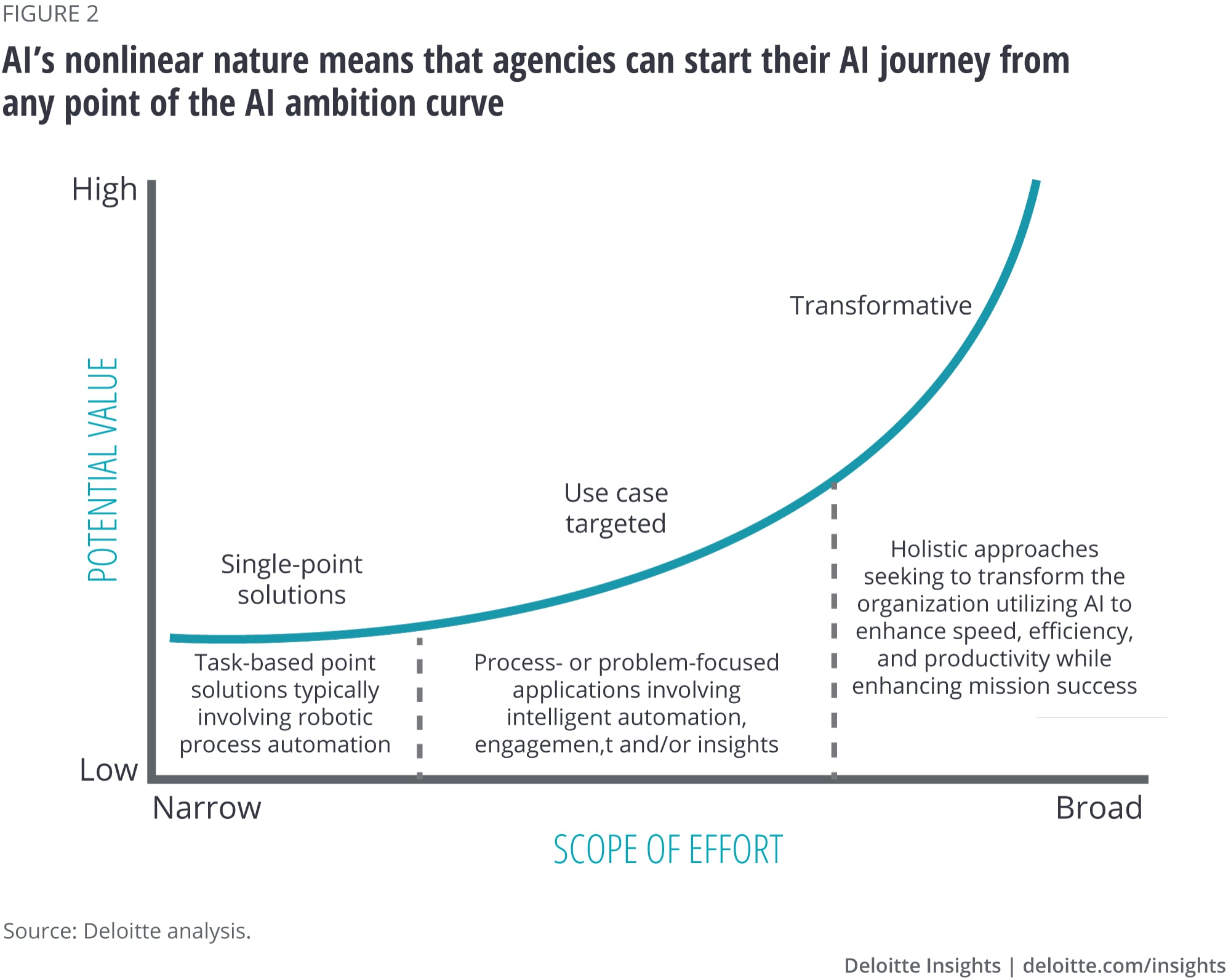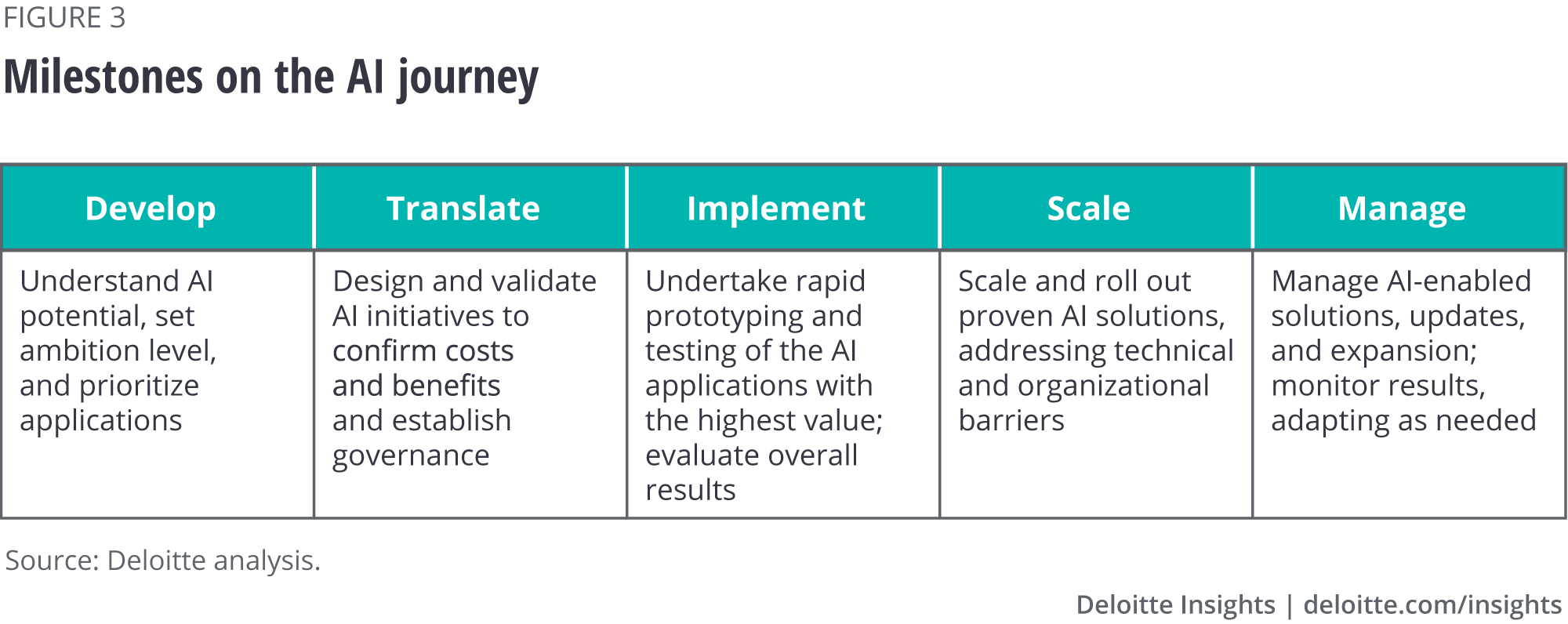
AI readiness for government Are you ready for AI?
8 minute read
24 January 2020
As various government agencies prepare to deploy artificial intelligence, a six-pronged framework can help them assess their AI readiness.
Is your agency ready for artificial intelligence (AI)? If not, what would it take to get to a place where it can enjoy the benefits of AI?
Learn more
Explore the Government & public services collection
Learn about Deloitte's services
Go straight to smart. Get the Deloitte Insights app
A government agency’s readiness for AI is not simply a question of preparing to buy and install new technology. The transformative nature of AI typically calls for preparation across multiple critical areas. To capture AI’s potential to create value, government organizations will need a plan to retool the relevant existing processes, upskill or hire key staff, refine approaches toward partnership, and develop the necessary data and technical infrastructure to deploy AI.
If an organization wishes to progress beyond pilots, it is helpful to consider the following distinct but interdependent areas in which to assess AI readiness: strategy; the organizational dimensions of people and processes; the technology-focused dimensions of data; technology and platforms; and the ethical implications of this transformative capability (figure 1).

All these six areas can be important because all are likely to require action and change during the AI journey defined by your agency. They can help you form an initial baseline as to where you are and how ready you are to undertake the journey:
- Strategy. Because AI is a transformative technology, alignment on direction and level of ambition is crucial. Define an AI vision and goals that align with organizational objectives, and then you can devise an approach for managing capability across the enterprise. (See our companion piece on “Crafting an AI strategy for government.”)
- People. Agencies may face challenges around accessing and recruiting necessary technical skills, as well as helping existing employees develop and deploy AI skills.1 To address these areas, consider integrating AI with human workflows, redefining talent models, and getting stakeholder buy-in through effective communications and change management.
- Processes. Establish, define, and design processes, controls, and governance systems to enable successful AI implementation. While AI pilots can serve to provide proof of AI’s potential, its true value cannot be captured until it is integrated with the work and processes of the organization.2
- Data. AI is only as good as the data upon which it is built, and its appetite for data is voracious. Design a data governance system that includes engineering and security. Data governance should include rules for sourcing, accessing, and quality management.3
- Technology and platforms. Procure and develop appropriate AI technology and platforms to operationalize AI assets, including those related to vendors, interoperability, and the computing environment. A variety of models for pursuing AI exist4 that vary in terms of platforms and ownership of technology (e.g., internal or in partnership), but, in all cases, AI requires a coherent approach that considers future requirements as AI scales within the organization and its usage evolves.
- Ethics. Establish mechanisms to understand and prevent AI bias, promote fairness and transparency, and ensure values and integrity are embedded in AI-driven initiatives. While any technology’s deployment should be ethical, AI brings issues such as transparency, privacy, and bias into particular focus.5
“To capture AI’s potential to create value, government organizations will need a plan to retool the relevant existing processes, upskill or hire key staff, refine approaches toward partnership, and develop the necessary data and technical infrastructure to deploy AI.”
Your AI readiness depends on your destination
While all six areas described above should be considered in all AI initiatives, the level of effort will largely depend both on the current state of the organization and the ambitiousness of the agency’s vision for AI (figure 2). Broadly speaking, an agency’s level of ambition can be categorized as:
- Narrow, single-point solutions
- Process- or problem-focused use cases
- AI-fueled transformation (which has the potential to bring the greatest change and highest value)

Generally speaking, the more ambitious an agency’s goal (further to the right in figure 2), the greater the value, the broader the scope, and, as a result, the greater the technical and organizational complexity.
Narrower, single-point solutions will typically demand less of a stretch by an organization. In these instances, AI can generate quick efficiencies by automating simple processes, often in back-office areas most prone to standardization. This allows staff to refocus their time and effort on more meaningful issues. If many such single-point opportunities exist, collectively, they can represent significant value. This path can be a relatively easy way for an agency to start using AI, with relatively quick returns to build support for AI solutions.
An approach focused on use cases considers common processes or problems that can be developed, then rolled out to other parts of the agency. This approach can yield a higher value but generally represents a greater challenge, calling for a higher state of readiness. It leverages similar types of AI across the enterprise—for example, intelligent chatbots in contact centers, or natural language processing and predictive analytics for units that deal with large amounts of data, whether structured (such as disparate HR databases) or unstructured (such as emails, memos, and documents). During this time, some agency leaders tend to emerge who are evangelists in scaling AI across their enterprise. Where these leaders will be located depends on which use cases are chosen and how the adoption of AI is governed: AI leaders can come from the IT, data security, finance, or operations businesses, but they may also be program or mission leaders.
Finally, truly transformational efforts seek to develop AI-fueled breakthroughs in back-office performance or mission outcomes. Leaders identify opportunities to fundamentally change a business process or mission area through a combination of AI technologies and organizational and process changes. Areas of opportunity can include reimagined clinical trial operations, AI-augmented or autonomous security clearances and vetting, smart cities, and revenue service collections. Transformational uses of AI can maximize the technology’s value as an enabler of organizational change.
An agency need not limit itself to a single approach. For example, consider the AI applications that the US Department of Defense (DoD) outlines in its AI strategy. The DoD has identified opportunities to deploy AI across the ambition curve. In terms of point solutions, using intelligent automation to reduce time spent on manual and repetitive tasks may generate low value per task, but given the DoD’s size, the aggregate opportunity is very high. The DoD is also looking at a specific use case for AI to enable predictive maintenance, anticipating the need for repairs to critical equipment in order to optimize inventory levels. And on the transformative end of the curve, developing a solution that can help predict or prevent cyberattacks or greatly advance the ability to explain AI algorithms could have transformative effects.6
Many commercial and government organizations are pursuing an approach that carries them from left to right along the ambition curve. Starting on the left with point solutions can give organizations experience in implementing AI in a less complex setting. As they install point solutions, organizations may also overhaul their data and technology infrastructure to create a stronger foundation for future AI implementations. Organizations progressing to AI for specific use cases often find that these projects provide solid evidence of scalable benefits, which can encourage strong advocacy for AI and its larger potential. Success or failure at this stage sets the tone for AI’s further deployment: While success tends to push an agency toward looking at more transformative opportunities, failure could deter agencies from fully scaling AI and may even discourage existing AI efforts.
Assessing your agency’s readiness depends on its current strategy, people, processes, data, technology and platforms, and ethics choices and governance, as well as on its high-level strategic choices concerning its level of ambition and path forward. These strategic choices should also reflect the agency’s goals, challenges, and available funding. But regardless of the precise character of your AI path and destination, there are some universal milestones along the way.
“Leaders identify opportunities to fundamentally change a business process or mission area through a combination of AI technologies and organizational and process changes.”
Key milestones on the AI journey
Developing a coherent AI strategy is the first step in creating a clearer set of choices for building and deploying AI capabilities. It defines an agency’s level of ambition, guides the prioritization of focus areas, and, along with an understanding of the agency’s readiness, identifies what critical capabilities need to be developed.
The AI strategy development phase sets the stage for the other critical milestones on the AI journey (figure 3). Note that an agency might cycle through this journey multiple times if it begins first with point solutions and takes them through to scaling and ongoing management, followed by broader use cases and, ultimately, AI-fueled transformation. By assessing where they are in this journey, agencies can evaluate which capabilities already exist and which need to be built from the ground up to achieve their AI effort’s desired outcomes.

Frequently asked questions about AI readiness
Some common questions heard from government leaders as they evaluate their AI readiness:
What’s the first thing I should do to become AI-ready?
Your first action should be to assess your organization in the six areas outlined in figure 1 and gauge any current gaps in capabilities, infrastructure, and resources relative to your ambition.
Our organization has been deploying simple automation. Should we put this on hold until we develop an AI strategy?
No. Even simple automation projects can be helpful in introducing new types of work into organizations, serving as a learning experience that prepares people for change. That said, before you move to your 15th or 50th automation, consider whether more complex use cases can lead to higher returns and mission impact.
In addition to dedicated data scientists and AI professionals, what other people resources are needed to start realizing value from AI?
Specific IT and AI skills are critical, but they are not sufficient for success. Also required are individuals who can help identify which business and mission areas to focus on, set up governance and ethics frameworks and processes, consider relevant center-of-excellence models, drive culture change and change management, develop and deliver worker retraining, and build new operating models.
We have always been fast in identifying use cases for specific tools or IT capabilities. How is AI different?
The nature of AI—the types of insights it can deliver (including predictive insights), its potential to enhance engagement with citizens and other stakeholders, and its ability to automate highly complex processes—means that any combination of AI (deep learning, computer vision, natural language processing, etc.) can fundamentally transform how you work in a way not formerly possible. But the breadth and diversity of use cases for AI means that agencies should choose carefully. If applied around low-value processes, in silos, or in areas that are not meaningful, AI is not likely to yield significant value.
AI has the potential to fundamentally transform government operations. However, agencies must be ready to take advantage of this potential. To do this, they should build a solid foundation by putting the right data and technology platforms in place, while at the same time developing the talent, strategy, and governance processes needed to effectively implement and use AI solutions.
AI’s transformative potential is so strong that it will likely eventually become ubiquitous across government. If this happens, then success in navigating the AI journey will play a large part in determining how effectively government agencies deliver on their mission.
© 2021. See Terms of Use for more information.
Learn more about AI in the public sector
-
Government & Public Services Collection
-
The future of intelligence analysis Article5 years ago
-
Crafting an AI strategy for government leaders Article5 years ago
-
Government executives on AI Article5 years ago
-
AI-augmented human services Article5 years ago
-
AI-augmented government Article5 years ago













